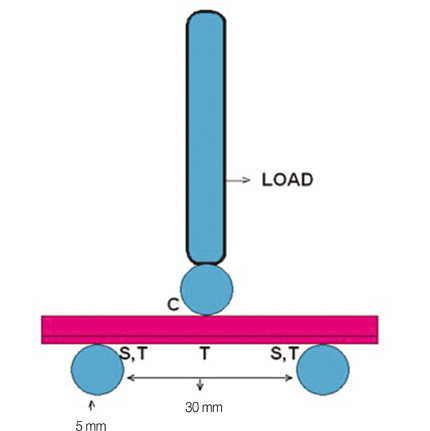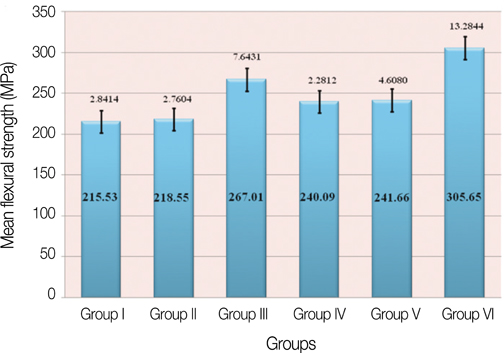J Adv Prosthodont.
2012 Feb;4(1):1-6. 10.4047/jap.2012.4.1.1.
The effect of different fiber reinforcements on flexural strength of provisional restorative resins: an in-vitro study
- Affiliations
-
- 1Department of Prosthodontics, VSPM's Dental College and Research Center, Nagpur, India. vaibhavk056@gmail.com
- 2Department of Prosthodontics, Saraswati Dhanwantri Dental College, Parbhani, India.
- KMID: 2284776
- DOI: http://doi.org/10.4047/jap.2012.4.1.1
Abstract
- PURPOSE
The aim of this study was to compare the flexural strength of polymethyl methacrylate (PMMA) and bis-acryl composite resin reinforced with polyethylene and glass fibers.
MATERIALS AND METHODS
Three groups of rectangular test specimens (n = 15) of each of the two resin/fiber reinforcement were prepared for flexural strength test and unreinforced group served as the control. Specimens were loaded in a universal testing machine until fracture. The mean flexural strengths (MPa) was compared by one way ANOVA test, followed by Scheffe analysis, using a significance level of 0.05. Flexural strength between fiber-reinforced resin groups were compared by independent samples t-test.
RESULTS
For control groups, the flexural strength for PMMA (215.53 MPa) was significantly lower than for bis-acryl composite resin (240.09 MPa). Glass fiber reinforcement produced significantly higher flexural strength for both PMMA (267.01 MPa) and bis-acryl composite resin (305.65 MPa), but the polyethylene fibers showed no significant difference (PMMA resin-218.55 MPa and bis-acryl composite resin-241.66 MPa). Among the reinforced groups, silane impregnated glass fibers showed highest flexural strength for bis-acryl composite resin (305.65 MPa).
CONCLUSION
Of two fiber reinforcement methods evaluated, glass fiber reinforcement for the PMMA resin and bis-acryl composite resin materials produced highest flexural strength. CLINICAL IMPLICATIONS: On the basis of this in-vitro study, the use of glass and polyethylene fibers may be an effective way to reinforce provisional restorative resins. When esthetics and space are of concern, glass fiber seems to be the most appropriate method for reinforcing provisional restorative resins.
MeSH Terms
Figure
Reference
-
1. Rosenstiel SF, Land MF, Fujimoto J. Contemporary fixed prosthodontics. 2001. 3rd ed. St. Louis: Mosby;380–386.2. Osman YI, Owen CP. Flexural strength of provisional restorative materials. J Prosthet Dent. 1993. 70:94–96.3. Haselton DR, Diaz-Arnold AM, Vargas MA. Flexural strength of provisional crown and fixed partial denture resins. J Prosthet Dent. 2002. 87:225–228.4. Hamza TA, Rosenstiel SF, Elhosary MM, Ibraheem RM. The effect of fiber reinforcement on the fracture toughness and flexural strength of provisional restorative resins. J Prosthet Dent. 2004. 91:258–264.5. Vallittu PK. Flexural properties of acrylic resin polymers reinforced with unidirectional and woven glass fibers. J Prosthet Dent. 1999. 81:318–326.6. Solnit GS. The effect of methyl methacrylate reinforcement with silane-treated and untreated glass fibers. J Prosthet Dent. 1991. 66:310–314.7. Dagar S, Pakhan A, Tunkiwala A. An in-vitro evaluation of flexural strength of direct and indirect provisionalization materials. J Indian Prosthodont Soc. 2005. 5:132–135.8. Uzun G, Hersek N, Tinçer T. Effect of five woven fiber reinforcements on the impact and transverse strength of a denture base resin. J Prosthet Dent. 1999. 81:616–620.9. Gutteridge DL. The effect of including ultra-high-modulus polyethylene fibre on the impact strength of acrylic resin. Br Dent J. 1988. 164:177–180.10. Koumjian JH, Nimmo A. Evaluation of fracture resistance of resins used for provisional restorations. J Prosthet Dent. 1990. 64:654–657.11. Geerts GA, Overturf JH, Oberholzer TG. The effect of different reinforcements on the fracture toughness of materials for interim restorations. J Prosthet Dent. 2008. 99:461–467.12. Vallittu PK. Ultra-high-modulus polyethylene ribbon as reinforcement for denture polymethyl methacrylate: a short communication. Dent Mater. 1997. 13:381–382.13. Kolbeck C, Rosentritt M, Behr M, Lang R, Handel G. In vitro study of fracture strength and marginal adaptation of polyethylene-fibre-reinforced-composite versus glass-fiber-reinforced-composite fixed partial dentures. J Oral Rehabil. 2002. 29:668–674.14. Stipho HD. Effect of glass fiber reinforcement on some mechanical properties of autopolymerizing polymethyl methacrylate. J Prosthet Dent. 1998. 79:580–584.
- Full Text Links
- Actions
-
Cited
- CITED
-
- Close
- Share
- Similar articles
-
- Comparison analysis of fracture load and flexural strength of provisional restorative resins fabricated by different methods
- A comparative study between degree of conversion and flexural strength of composite resins
- Comparative study of flexural strength of temporary restorative resin according to surface polishing and fabrication methods
- Comparison of flexural strength according to thickness between CAD/CAM denture base resins and conventional denture base resins
- THE EFFECT OF PLASMA-TREATED POLYETHYLENE FIBER ON THE FLEXURAL STRENGTH OF COMPOSITE RESIN IN VARIOUS APPLIED PORTIONS



